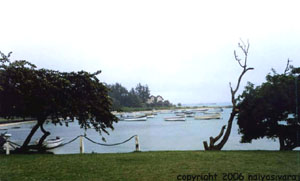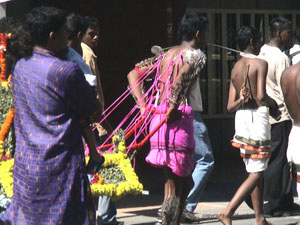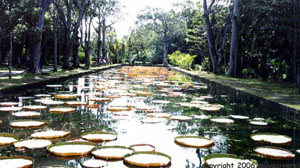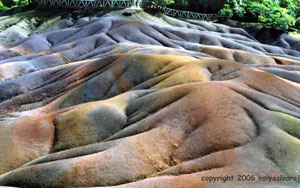Apr 13, 2025
Apr 13, 2025
Getting lost twice is not my idea of a great vacation. But that is precisely what happened when I was in Mauritius, trying unsuccessfully to experience the place by bus and scooter ' which I found was quite impossible in a country that closes down by early evening. And after the getting-lost-on-the-scooter fracas, my husband and I decided to hire one of those little jeeps everyone seemed to be driving around. Monetarily, it did set us back a bit, but given a choice between getting lost or not, this was way better! The day was balmy and the jeep topless and I discovered to my pleasure that sometimes it does feel good to move away from the only-local-conveyance policy that I stuck to on every trip. Anyone going there should experience a good ride around the coast.
If starting from the north, the drive can easily be completed in two days, at the most three, taking in everything that has to be seen.
 After plotting a drive plan on a map of the island, start at the northern most point of Cap Malheareaux, a sleepy little village, full of charming, hedged off vacation homes. After parking at the little red roofed church built in the 18th century, idle at the beach with a view of the impressive Gunner's Conner; later follow the shoreline for a little while to check out the cool backyards of the houses, each complete with verandas, back gardens, a private jetty and boat. And a bit of beach. Local fishermen offering to take visitors out to sea abound here, and though tempting, you may have to decline because of their high, touristy rates. Apparently this was the first settled fishing village of the island and is thoroughly quiet and calm.
After plotting a drive plan on a map of the island, start at the northern most point of Cap Malheareaux, a sleepy little village, full of charming, hedged off vacation homes. After parking at the little red roofed church built in the 18th century, idle at the beach with a view of the impressive Gunner's Conner; later follow the shoreline for a little while to check out the cool backyards of the houses, each complete with verandas, back gardens, a private jetty and boat. And a bit of beach. Local fishermen offering to take visitors out to sea abound here, and though tempting, you may have to decline because of their high, touristy rates. Apparently this was the first settled fishing village of the island and is thoroughly quiet and calm.
 The nearby town of Grand Baie is where all the action lies, unlike the rest of the towns - pubs, continental restaurants and Sunset Boulevard, a designer shopping center set very prettily on the beach. The beach front is lined with push carts where you can buy your lunch if you are cutting costs. Fried rice, biryani, stuffed rotis, soup; it was delicious for a great rate. This is where you want to be if you are planning to try water sport too. Parasailing, paragliding, underwater walks, scuba diving, glass bottomed boat rides and so on. None of the activities are too pricey and a go at each one, for as less as Rs 100, is a definite must, especially for watching sea life ' colorful fish and lobsters. This is a good place for picking up beach or swim wear too - bikinis, sarongs, beach towels are abundant and incredibly cheap. For souvenirs head to the Grand Baie Souvenir Shop which sells masks, handmade paper, and the ever present dodo in various forms. For more traditional crafts, you can go further down the road where craft shops sell vibrant hand-woven baskets and jewelry. We were also lucky enough to witness the traditional 'cavadee' celebrations of the resident Tamil community at the nearby Murugan temple.
The nearby town of Grand Baie is where all the action lies, unlike the rest of the towns - pubs, continental restaurants and Sunset Boulevard, a designer shopping center set very prettily on the beach. The beach front is lined with push carts where you can buy your lunch if you are cutting costs. Fried rice, biryani, stuffed rotis, soup; it was delicious for a great rate. This is where you want to be if you are planning to try water sport too. Parasailing, paragliding, underwater walks, scuba diving, glass bottomed boat rides and so on. None of the activities are too pricey and a go at each one, for as less as Rs 100, is a definite must, especially for watching sea life ' colorful fish and lobsters. This is a good place for picking up beach or swim wear too - bikinis, sarongs, beach towels are abundant and incredibly cheap. For souvenirs head to the Grand Baie Souvenir Shop which sells masks, handmade paper, and the ever present dodo in various forms. For more traditional crafts, you can go further down the road where craft shops sell vibrant hand-woven baskets and jewelry. We were also lucky enough to witness the traditional 'cavadee' celebrations of the resident Tamil community at the nearby Murugan temple.
At Pointe aux Cannoniers, the shop of a friendly Bhojpuri-descended couple who build ship models, 'Galerie de Mascarenhas', proved to be a great place. He carves the wood, she masts them, and they ship them out to customers if so required. They graciously showed us around their workshop. Ship building is such intricate work and requires tremendous concentration and skill, we were quite amazed. The Bounty and other famous ones, some as tall as two feet, were on the expensive side, so we settled for a little catamaran with blue sails. Model ship building is one of the core crafts of the country, and is the best souvenir to take back. From there, pass Mont Choisy, to the famed Trou aux Biches resort. The resort organizes a sega dance show every Wednesday evening on the beach, which we were just on time to catch. The troupes were show stoppers, arriving on the scene on a catamaran carrying lighted torches.
 The drive to Pamplemousses in central Mauritius through immense, unending sugarcane fields and dark forest is wonderful. The village itself surrounds the beautiful St.Francis Church, the oldest on the island. Laid down by French botanist Pierre Poivre in 1768, the garden is best known for its much photographed Giant Amazon water lilies and its restored colonial mansion, Chateau Mon Plaisir. The lily pads are as wide as two feet each, and can seemingly bear the weight of a new-born baby! Right around the corner is Beau Plan, a former sugar factory innovatively turned into a museum. For a small fee you get a book, a film, and a look at interactive displays of Mauritian history and economy. The section on the Indian coolie immigration - the majority of them Tamils and Biharis with a smattering of other communities thrown in - which took place in the early 1800s, is totally fascinating. Sugar is the mainstay of the Mauritian economy then and now; the display of old factory machines polished and put together showed how it is done and nine different sugars can be sampled at the small gift boutique at the exit.
The drive to Pamplemousses in central Mauritius through immense, unending sugarcane fields and dark forest is wonderful. The village itself surrounds the beautiful St.Francis Church, the oldest on the island. Laid down by French botanist Pierre Poivre in 1768, the garden is best known for its much photographed Giant Amazon water lilies and its restored colonial mansion, Chateau Mon Plaisir. The lily pads are as wide as two feet each, and can seemingly bear the weight of a new-born baby! Right around the corner is Beau Plan, a former sugar factory innovatively turned into a museum. For a small fee you get a book, a film, and a look at interactive displays of Mauritian history and economy. The section on the Indian coolie immigration - the majority of them Tamils and Biharis with a smattering of other communities thrown in - which took place in the early 1800s, is totally fascinating. Sugar is the mainstay of the Mauritian economy then and now; the display of old factory machines polished and put together showed how it is done and nine different sugars can be sampled at the small gift boutique at the exit.
The capital city, Port Louis, locked in by the sea on one side and craggy mountains on the other, was the next stop. Small and with a kind of old world charm to it, statues of 18th century French Governor Mah' de Labourdonnais and Father of the Nation Ramgoolam Seersowagur, dominate the main street. No trip to a capital city can be complete without a sampling of its history so visit the Blue Penny Museum run by Mauritius Post (Mauritius, remarkably, was among the first countries in the world to issue the first postage stamps); and the relatively unknown L' Muse' de la Photographic on Churchill Street which has a huge display of photographs taken over the last 160 years, with as many old negatives. The owners of this private museum are very passionate about preserving the island's history and they've succeeded to a great extent. The afternoon is best spent relaxing at the Le Caudon Waterfront, built along the harbor with countless number of pubs and restaurants set along the water's edge. The craft shops inside have an amazing range. Don't forget to pick up a glass or ceramic dodo, the dumb bird which is the ubiquitous symbol of the island, which became extinct 300 years ago.
Make sure you leave by 5 as everything shuts down by then. Take a detour from the highway beyond Port Louis to the Creole plantation house, La Maison Cr'ole Eur'ka, standing on magnificent gardens on the base of the Moka Mountains. Eur'ka houses a museum with antique furniture and old photographs and is proof of how charming restored period houses can be.
At Curepipe, climb the hill to view Trou aux Cerfs, an ancient volcanic crater, from which Mauritius itself was formed some 800,000 years ago; and a 360 degree view of volcanic mountains ringed by the distant ocean. Rose Hill, known for its cardigan trade, is close by if you are intent on shopping or you can take the road to Tamarin Falls for rock climbing. Seven falls fall into a quiet pool perfect for swimming. If that is not your cup of tea either, drive south toward Mahebourg on the eastern coast. The country's history started right here when in 1638 it became the first port for European settlers. It is one of the few places in Mauritius where 17th century colonial buildings have been well maintained. The Naval Museum has a beautiful collection of artifacts and the local bazaar was fun - colorful, rowdy, and full of junk.
Blue Bay, just south of Mahebourg is a beautifully azure lagoon, stop for a quick dip in the sea before driving along the southern coast to the cliffs of Gris-Gris. This is the southernmost tip and for anyone seeing cliffs for the first time, it's sure to be an exhilarating experience. Unlike elsewhere the sea is rough on the south coast and swimming is generally forbidden. The water crashing and foaming against the rocks and big waves reaching to a height of some 12 feet is a dramatic sound show. It is a rather lonely place, most of the time devoid of tourists; you can see nothing but the ocean stretching away into the horizon. At the Rochester Falls, a short distance away among silent cane fields and potholed lanes, we had to struggle to keep away touts who insisted on putting up a diving show by local Indian boys for a lot of money.
 From there it was up into the hills to the Chamerel Estate where you can pet sweet old tortoises, a native species, some of them more than a hundred years old. The seven colored earth is unique, and possibly that way because it is formed of volcanic remnants; looking like the wrinkled jowls of an old lady. It's best to be here early in the morning when the colors are brought out superbly by the sun - and because they also close early. The silver Chamerel waterfall falling 100 ft (on the same property) has been voted among the best things to see on earth, and it was truly lovely. Driving down is most spectacular especially if you are on time to view the sunset. Park at the side and take in the changing colors of the ocean from aquamarine to pink to violet. Simply lovely!
From there it was up into the hills to the Chamerel Estate where you can pet sweet old tortoises, a native species, some of them more than a hundred years old. The seven colored earth is unique, and possibly that way because it is formed of volcanic remnants; looking like the wrinkled jowls of an old lady. It's best to be here early in the morning when the colors are brought out superbly by the sun - and because they also close early. The silver Chamerel waterfall falling 100 ft (on the same property) has been voted among the best things to see on earth, and it was truly lovely. Driving down is most spectacular especially if you are on time to view the sunset. Park at the side and take in the changing colors of the ocean from aquamarine to pink to violet. Simply lovely!
The Black River Gorges National Park, just below the Chamerel hills is 12,000 hectares of protected forest which offers several hiking trails of varying lengths. The 14 km one to Grand Bassin and back is the most popular because the vast lake is the metaphoric Ganges for immigrant Indians where they perform their religious rites from birth to death.
Take the hilly, coastal road up the western shoreline to Flic en Flac, the most popular public beach on the eastern coast; and where the grandest star resorts are located, here and in Wolmar. From here it was on to Albion where we spent the evening sitting beneath an old lighthouse and watching the water darken. If there is time and energy enough you can visit the vibrant weekly market at Quatre-Bornes on the central highway.
Back at quiet little Mont Choisy, filled with resorts and villas, you'll find it a good place for an afternoon of sunbathing on the beach. There are plenty of cozy, private coves to relax in when not swimming.
(In two days you would have covered the whole of the island, at the most three. Contact Hertz or Avis Rent-a-Car offices where you are staying for rental options. The starting rate will be around Mauritian Rs 800 per day for a basic model. Don't forget to take along a heavy-duty torchlight. And of course don't forget a road map. If the rental agency does not give you one (most do), you can purchase it at a good store for around M Rs 25. Throw in some snacks and bottled water; a sweatshirt or woolens for the cold evenings, and you are all set to go. Other must take-along are swimwear, a good pair of sunglasses, and high density sun block lotion ' you could decide to stop at some secluded blue beach).
12-Nov-2006
More by : Naiya Sivaraj